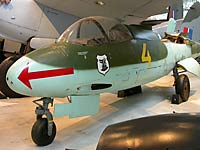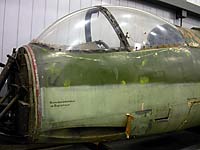| page 1 of 3 |
| Wings of Eagles Museum - Heinkel HE-162 Salamander
Bill Maloney 11/10/2010 |
| page 1 of 3 |
Two other Heinkel HE-162 Salamander jet fighters at the Canada Aviation Museum |
|
 |
 |
| Heinkel HE-162 Salamander 120076 at the Canada Aviation Museum in Ottawa, Canada in 2003. It has since been traded to Aero Vintage Ltd. in England | Heinkel HE-162 Salamander 120086 at the Canada Aviation Museum in Ottawa, Canada. It is currently dissasembled in the Annex and in poor condition. |
Length: 29 feet, 8 inches
Wingspan: 23 feet 7 inches
Height: 8 feet, 6 inches
Crew: 1
Weight: Empty - 3,660lbs Takeoff - 6,100lbs
Max Speed: 562mph
Cruise Speed: N/A
Range: 230 miles / 30 minutes of powered flight
Service Ceiling: 29.400
Fuel Capacity: gallons internally
Powerplant: Junkers 003E-1 Orkan turbojet engine 1,760lbs thrust
Armament:
Two 20mm MG 151 Cannon
First Flight : December 6, 1944
This particular example of the partly plywood Heinkel HE-162 Salamander / Volksjager is actually an outstanding reproduction done by George Lucas of NY State. It is simply fantastic! His attention to detail and build quality is amazing. I found this to be the most interesting exhibit of the museum. Here is a Youtube Video of the HE-162 Salamander. It is actually a collection of B&W still photographs of the German jet in WWII. The HE-162 is an interesting contradiction in technologies. It used the most advanced and powerful engine of the period, yet much of the airframe was plywood and constructed by slave laborers under the whip of the Nazi SS. Thankfully for the allied pilots and crews some of these prisoners would urinate in the glues used to bond the plywood panels together, and they could and did delaminate in flight. During a demonstration flight for Adolph Hitler and other high ranking Nazi officials an aileron on the HE-162 delaminated causing the Salamander to snap roll and crash, killing one of the Luftwaffe's most valuable test pilots, Flugkapitän Gotthold Peter. The plane was envisioned to be used by Hitler Youth after only a few hours of training. Yet it required a skilled hand to fly well, and with the engine mounted above the center of gravity advancing the throttle caused the nose to go down, and retarding it made the nose pitch up, making for interesting landing qualities for green pilots. The Junkers Jumo 004 had a lifespan of 50 hours which was rarely achieved. The intake of that same turbojet engine is located right behind the pilot's canopy. Were the pilot to try to bail out with the engine running, he would either get sucked in or hit it very very hard. If he missed the engine he would impact one of the twin rudders. As a result of this pilot unfriendly configuration the Salamander was equipped with the world's first ejection seat. Another name for the HE-162 is the Volksjager, or People's Fighter.
Wings of Eagles Museum Main Page
Military & Aviation Museums Main Page